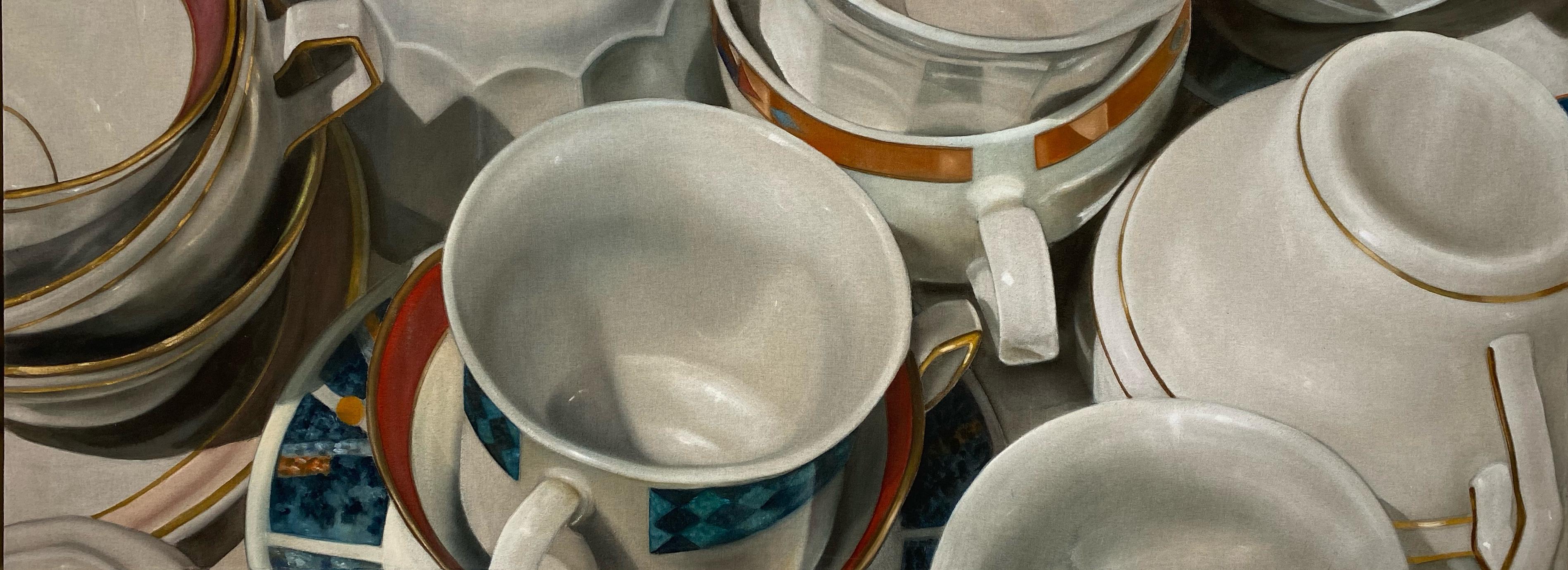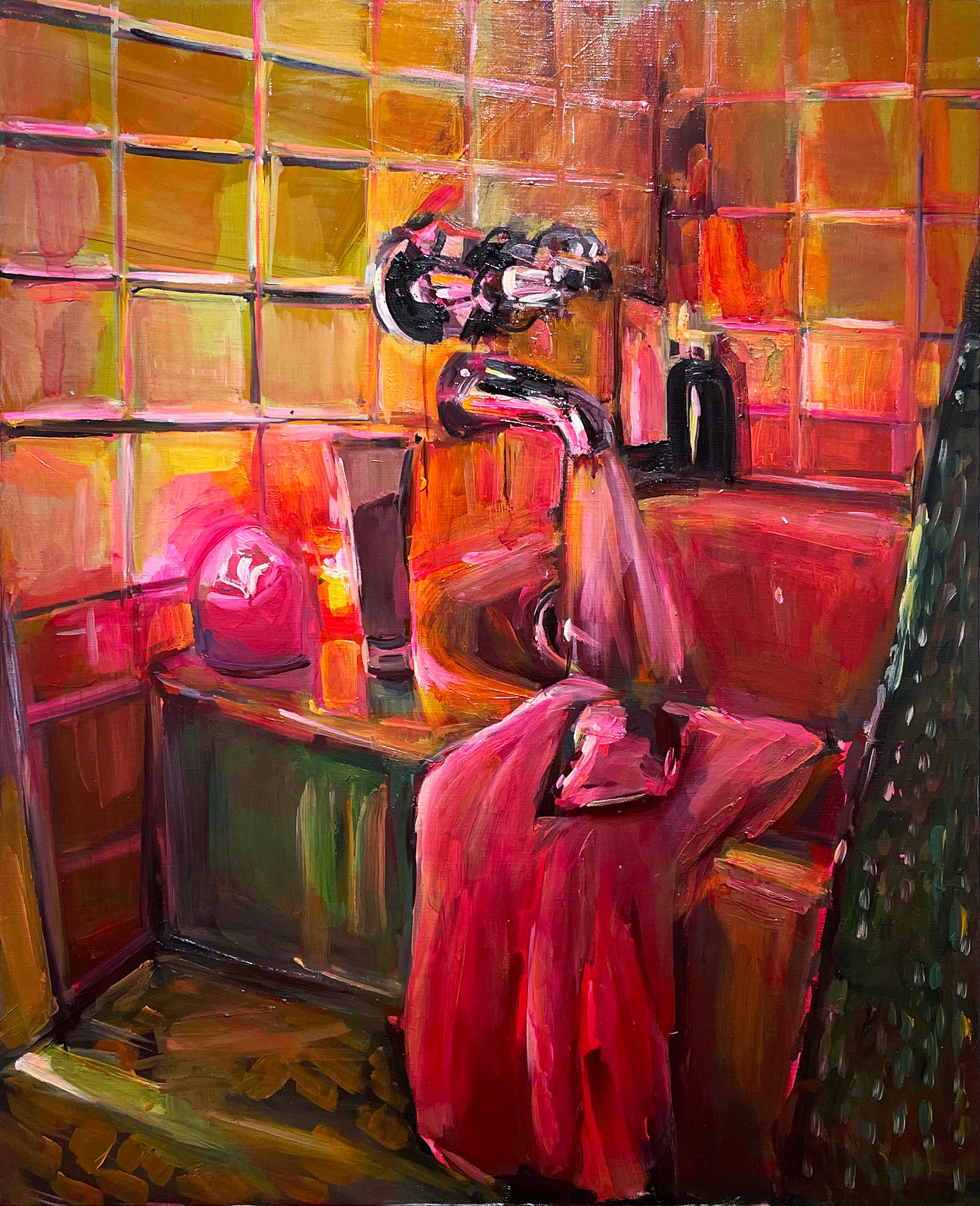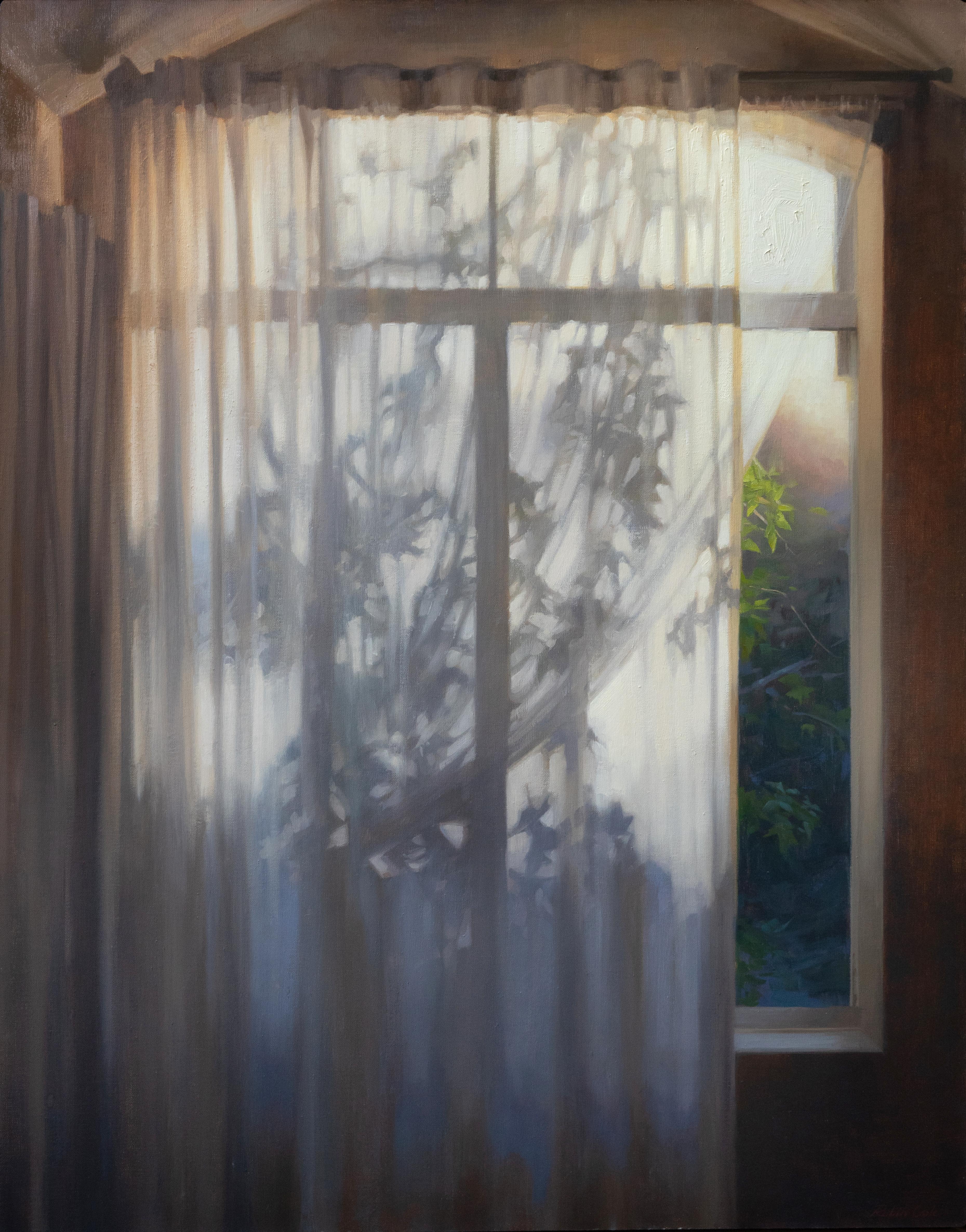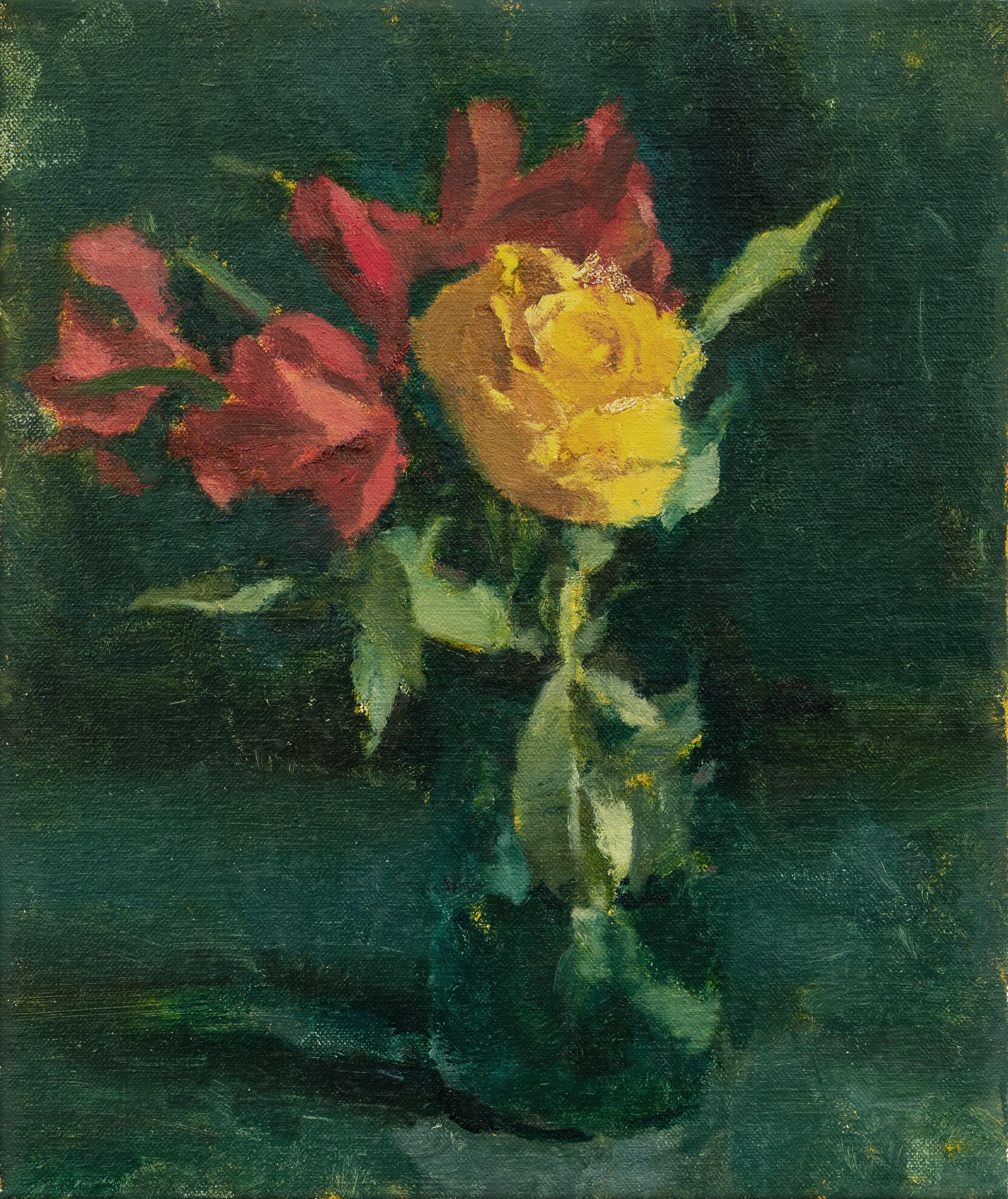Items Similar to 1911 Modern Floral Still Life of Ranunculus and Mustard Oil Painting on Linen
Video Loading
Want more images or videos?
Request additional images or videos from the seller
1 of 11
Walter Pach1911 Modern Floral Still Life of Ranunculus and Mustard Oil Painting on Linen1911
1911
About the Item
Wonderful modern floral still life oil painting of ranunculus in white vase and mustard weed on table by acclaimed artist and art critic Walter Pach (American, 1883-1958), 1911. Pach was taught by Leigh Hunt, William Merritt Chase, and Robert Henri. Several of his works are in the collections of The Metropolitan Museum of Art, The Whitney, The New York Public Library, and The Museum of Modern Art, New York.
Paintings up against the wall show the artist's studio and add a real-life genre aspect to painting.
Signed and dated upper left corner.
Condition: Good; prior restoration work evident on verso but undetectable on front; frame is antique and included as-is as a courtesy.
Image size: 18"H x 24"W.
Walter Pach (July 11, 1883-November 27, 1958), artist, critic, historian, dealer, teacher, and lecturer, was born in New York City, the son of Gotthelf Pach, photographer, and Frances Wise, an influential member of the Ethical Culture Society in New York. Pach grew up in a comfortable, middle-class home with one brother, Alfred. He was graduated with a Bachelor of Arts from The College of the City of New York in 1903.
Thereafter he received artistic training in Manhattan under Leigh Hunt, William Merritt Chase, and Robert Henri. He also studied at the Académie Ranson in Paris. Between 1903 and 1910, Pach was the agent for the Chase European Summer School. Although living in New York City most of his life, Pach resided abroad frequently. He was in Paris intermittently between 1903 and 1913, and from 1929 through 1932; and lived in Mexico City in 1922 and during 1942 and 1943.
In February 1914 he married Magdalene Frohberg, of Dresden, Germany, whom he had met in Florence in 1907. The couple had one son, Raymond. After Magda's death in 1950, Pach remarried Nikifora Loutsi, now Nikifora N. Iliopoulos. Walter Pach was a seminal figure in the history of early twentieth-century American art. His importance lies in his roles as an art critic, historian, lecturer, agent, and champion of modernism.
Pach played a major part in the organization of the famous International Exhibition of Modern Art, better known as the Armory Show. This event, held in New York, Chicago, and Boston in 1913, was the first large-scale exhibition to bring avant-garde European painting and sculpture to America, thereby changing the course of art in the United States.
While living in Paris during the early 1900s, Pach became friends with several of the most advanced painters and sculptors of the time. He was instrumental in securing loans from such artists as Henri Matisse, Odilon Redon, Marcel Duchamp, and Constantin Brancusi and became, in essence, the European agent for the Armory Show. Through his work as a publicist, chief salesperson, and lecturer during the show's run in America Pach helped promote and disseminate the ideas of modernism to large audiences. During the course of the exhibition he met John Quinn and Walter Arensberg, individuals whom, through Pach's assistance, amassed two of the earliest and most significant collections of modern art in America.
During World War I, Pach acted as a liaison between several of the European artists and American galleries and collectors. He borrowed pieces from Georges Rouault, André Derain, Raoul Dufy, Raymond Duchamp-Villon, and others for display at various venues in New York and Philadelphia, and he was the representative for the Carroll Galleries of New York. From 1914 until 1926 Pach acted as Henri Matisse's agent in the United States. With the war raging on the continent, this was a critical time for modernism and its proponents.
Through Pach's efforts the avant-garde European artists found not only a place to exhibit their works, but individuals to purchase them. Pach was also a staunch supporter of American and Mexican painters and sculptors of his day. He formed close bonds with John Sloan, Maurice Prendergast, Arthur B. Davies, Diego Rivera, and José Orozco and wrote articles on some of these artists.
In addition to arranging shows at commercial galleries Pach helped found, and was treasurer of, the Society of Independent Artists. From 1917 to 1944 this New York organization held annual exhibitions that promoted all styles of foreign and American art. Pach devoted a substantial amount of his career to writing. Some of his major works include: Georges Seurat (1923); Raymond Duchamp-Villon, sculpteur (1924); The Masters of Modern Art (1924); Ananias, or the False Artist (1928); Queer Thing, Painting (1938); Ingres (1939), and The Classical Tradition in Modern Art, published posthumously in 1959.
In addition to these books, Pach contributed numerous articles to such newspapers and magazines as the New York Times, Scribner's Magazine, The Dial, The Freeman, The Century, L'Amour de l'art, L'art et les artistes, and Gazette des Beaux-Arts. His piece on Cézanne in Scribner's Magazine (December 1908) was the first serious discussion of the artist to appear in English. Pach also translated several books, among them noted French critic and art historian Elie Faure's five volume History of Art (1921-1930) and The Journal of Eugene Delacroix (1937).
Between 1906 and his death in 1958, Pach lectured extensively throughout the United States. His topics covered the history of art in general, with an emphasis on modernism. He was an instructor at New York University, Columbia University, The College of the City of New York, the Art Students League in Manhattan, the University of California, Berkeley, and the National University of Mexico, in Mexico City.
Through these activities Pach introduced modern as well as other art to a broad range of the populace. Although most renowned for his work as critic and speaker, Pach considered himself first and foremost an artist. He created and exhibited numerous paintings, watercolors, and etchings and his style ranged from realistic to abstract. Most of his mature works are either still lifes or portraits.
Several of his works are in the collections of The Metropolitan Museum of Art, The Whitney, The New York Public Library, and The Museum of Modern Art, New York. The history of modern art and art criticism would have been quite different without the work of Walter Pach. He not only championed the art of his own time, but also had a comprehensive knowledge of the history of art. His books, articles, and lectures discussed a wide range of subjects from ancient Mexican and Native American art to early twentieth-century European and American modernism. Pach firmly believed in the power of art to shape and effect people's lives. Throughout his career he strove to promote an understanding of, and appreciation for, the art of different nations and eras.
He fought to make art a vital part of life in America. As John Quinn, Pach's friend and colleague, remarked, "I believe that before very long his contributions would come to be regarded as the best art criticism that we would have."
Walter Pach died in New York City at the age of seventy-five.
- Creator:Walter Pach (1883 - 1953)
- Creation Year:1911
- Dimensions:Height: 21 in (53.34 cm)Width: 27 in (68.58 cm)Depth: 1 in (2.54 cm)
- Medium:
- Movement & Style:
- Period:
- Condition:Very Good. Previous conservation/restoration done (see verso image) which is not visible/evident on recto. Frame is included as-is as a courtesy.
- Gallery Location:Soquel, CA
- Reference Number:
About the Seller
5.0
Platinum Seller
These expertly vetted sellers are 1stDibs' most experienced sellers and are rated highest by our customers.
Established in 1986
1stDibs seller since 2014
2,514 sales on 1stDibs
Typical response time: <1 hour
- ShippingRetrieving quote...Ships From: Soquel, CA
- Return PolicyA return for this item may be initiated within 14 days of delivery.
More From This SellerView All
- Roses with Vase Still Life by Bonnie Beach RyanLocated in Soquel, CARoses and vase by Bonnie Beach Ryan (American, 1901-1940). In 1933, Bonnie Beach Ryan held her first solo show of flower and still life paintings at the Dana Bartlett...Category
1930s American Impressionist Still-life Paintings
MaterialsLinen, Oil
- Early 20th Century Summer Floral Still Life - Zinnias, Delphiniums, Corn FlowersLocated in Soquel, CAEarly 20th Century Summer Floral Still Life - Zinnias, Delphiniums, Corn Flowers Substantial and gorgeous early 20th Century still life of summer flowers in cream bowl with Zinnia, Delphiniums, and Corn Flowers with pink candle by Volney...Category
1930s Realist Still-life Paintings
MaterialsLinen, Oil
- Copper Pitcher and Basket of Grapes, Vintage Still-Life with Brick WallLocated in Soquel, CAVintage 1970s still-life of a basket of green grapes and a copper pitcher against an interesting background of a distressed brick wall, by California painter Darlene Cantorna...Category
20th Century American Impressionist Still-life Paintings
MaterialsOil, Linen
- "Nature Morte" Paris School Still-Life with Coffee Grinder MillBy Maurice BlondLocated in Soquel, CAMid century kitchen still-life with an antique coffee grinder, ladle, and measuring cup on a table by Maurice Blond (Polish, 1899-1974), c.1950s. Signed ...Category
Mid-20th Century Impressionist Still-life Paintings
MaterialsLinen, Oil
- Mid Century Roses and Apple Blossoms Floral Still LifeLocated in Soquel, CAGorgeous mid century floral still life in soft spring palette with roses and apple blossoms by J. Herron (American, 20th Century), circa 1960. Signed lower right. Unframed. Image siz...Category
1960s American Impressionist Still-life Paintings
MaterialsOil, Linen
- Mid Century Still-Life with Fruit, Pineapple, and PitcherBy Joseph YeagerLocated in Soquel, CAVibrant, colorful still-life of fruit arranged in front of a bowl and pitcher by Joseph Yeager (American, 20th Century). Circa 1940. This piece is partially incomplete. Unsigned, but...Category
Mid-20th Century American Realist Still-life Paintings
MaterialsLinen, Oil
You May Also Like
- Domestic ArchitectureLocated in Miami, FLThe title of the series is Arquitecturas Domésticas and has this interesting link with the a Spanish Baroque. What Gloria is doing with these pieces is reinterpreting the Spanish Bar...Category
2010s Contemporary Still-life Paintings
MaterialsLinen, Oil, Pigment
- Domestic ArchitectureLocated in Miami, FLThe title of the series is Arquitecturas Domésticas and has this interesting link with the a Spanish Baroque. What Gloria is doing with these pieces is reinterpreting the Spanish Bar...Category
2010s Contemporary Still-life Paintings
MaterialsLinen, Oil, Pigment
- Ritual (2022) oil, linen, impressionist hot pink interiors, bathtub, candlelightBy Ekaterina PopovaLocated in Jersey City, NJ"Ritual is an original oil painting on linen measuring 30" high x 24" wide x 1.25" deep by Ekaterina Popova, founder of Create Magazine. She uses vibrant, saturated pigments in her serene and inviting candlelit bath scene...Category
2010s Contemporary Interior Paintings
MaterialsLinen, Oil
- "Beginnings" Oil PaintingBy Robin ColeLocated in Denver, CORobin Cole's (Us based) "Beginnings" is an oil painting that depicts a window partially blocked with a white curtain, with the contending light and shadows making patterns on its for...Category
2010s Realist Still-life Paintings
MaterialsOil, Panel, Linen
- "Still Life with Flowers XXXII" Oil PaintingBy Jordan WolfsonLocated in Denver, COJordan Wolfson's (US based) "Still Life with Flowers XXXII" is an oil painting that depicts yellow and purple flowers gathered in a vase cont...Category
2010s Impressionist Still-life Paintings
MaterialsLinen, Oil
- "Still Life with Flowers XXXI" Oil PaintingBy Jordan WolfsonLocated in Denver, COJordan Wolfson's (US based) "Still Life with Flowers XXXI" is an oil painting that depicts yellow and red flowers gathered in a vase contrasted with a forest green background. Jord...Category
2010s Impressionist Still-life Paintings
MaterialsOil, Linen





